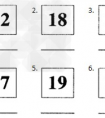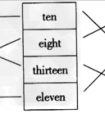There are _____ in a year.[ ]A. twelve month B. twelve monthsC. twelfth month D. twelfth months-六年级英语
例如:in May在五月; in July在七月。
为了简便起见,月份与日期连用时,月份常用缩写形式表示。
缩写形式除May,June,July外,其它的月份都由其前三个字母表示,但September除外。
January——Jan.一月
February——Feb.二月
March——Mar. 三月
April——Apr.四月
August——Aug.八月
September——Sept.九月
October——Oct.十月
November——Nov.十一月
December——Dec.十二月
注:这里缩写形式后面加点不能省略,因为它是表示缩写形式的符号。
C.日期用定冠词the加序数词表示。在哪一天要添加介词on。
National Day is on Oct. 1.
国庆节是十月一日。(读作 October first)
此句也可以表示为 National Day is on the 1st of October.
May 5 五月五日(读作May fifth)
也可以表示为the fifth(5th)of May
Mar. 1(st) 三月一日(读作March first或 the first of March)
5. 表示不具体、不确切的时间,如世纪、年代、年份、月份时,用介词in表示;
表示具体确切的某一天用介词on表示通常情况下morning,afternoon,evening等词前用介词in。
但是,当这些词前后有一修饰限定的词作为定语,把它们限定为某一天早晨、下午或晚上时,介词in应改为on。
这里的修饰限定词可以是介词短语、名词、形容词、定语从句等。
On a cold morning,the old man died lonely in his house.
在一个寒冷的早晨,这个老人孤独地死在自己的房子里。
I don/’t want to be disturbed on nights when I have to study.
我不愿意在我必须学习的晚上被打扰。
The accident happened on the afternoon of July 7.
这次事故发生在7月7日下午。
We are to have a small test on Monday morning.
星期一早晨我们将进行一次小测验。
四、加减乘除表示法
1. “加”用plus,and或add表示;“等于”用is,make,equal等词表示。
2+3=? 可表示为: How much is two plus three?
2+3=5
Two plus three is five.
Two and three is equal to five.
Two and three make five.
Two added to three equals five.
If we add two to/and three, we get five.
二加三等于五
2. “减”用 minus或 take from表示
10-6=? How much is ten minus six?
10-6=4
Ten minus six is four.
Take six from ten and the remainder is four.
Six (taken) from ten is four.
十减去六等于四
3. “乘”用time(动词)或multiply表示
3×4=? How much is three times four?
3×4=12
Three times four is/are twelve.
Multiply three by four,we get twelve.
Three multiplied by four makes twelve.
三乘以四等于十二
4. “除”用divide的过去分词形式表示
16÷4=? How much is sixteen divided by four?
16÷4=4
Sixteen divided by four is four.
Sixteen divided by four equals/gives/makes four.
十六除以四等于四。
考点名称:复数名词
- 复数名词:
指名词的数量大于“一”,如:two books, some students
名词变复数:
1、一般情况下,词尾加s。如:students,apples,bags,trees,books,brothers
2、s,x,z,sh,ch等结尾的名词,词尾加es。如:glasses,boxes,brushes,matches
3、y结尾的名词分两种情况,“辅音字母+y”结尾的名词,将y变为ies;
“元音字母+y”结尾的名词,直接在词尾加s。
以辅音字母加y结尾的名词,变y为i加es:cities,babies,enemies。
以元音字母加y结尾的名词,如:boys
4、f或fe结尾的名词,一般将f或fe变为ves。如:leaf-leaves, wife-wives, knif-knives
5、规则名词:foot→feet,tooth→teeth, child→children,man→men, woman→women,
sheep→sheep,deer→deer, mouse→mice. - 名词变复数规则:
巧记以f、fe结尾的可数名词复数情况
构成方法
例词
读音
一般情况
在词尾加-s
desk→desks
map→maps-s在清辅音后发/s/
day→days
girl→girls-s在元音和浊辅音后发/z/
以s,x,ch,sh结尾的词
在词尾加-es
bus→buses
box→boxes
watch→watches
fish→fishes-es发/iz/音
以辅音字母加-y结尾的词
变y为i再加-es
family→families
factory→factories
party→patries-ies发/iz/音
以元音字母加-y结尾的词
在词尾加-s
day→days
boy→boys
key→keys-s发/z/音
以f或fe结尾的词
变f或fe为v再加-es
knife→knives
life→lives
wife→wives
half→halves-ves发/vz/音
以辅音字母加-o结尾的词
在词尾加-es
potato→potatoes
tomato→tomatoes
hero→heroes-es发/z/音
以元音字母加-o结尾的词
在词尾加-s
radio→radios
zoo→zoos-s发/z/音
妻子骑牛拿起刀,wife,calf,knife↑
追得贼狼满街跑,thief,wolf→→→变f或fe为v,再加es
碰倒架子丧己命,shelf,self,life↓
手帕树叶半空飘。handkerchief,leaf,half↓ - 英语名词单数变复数口诀:
(一) 规则变化
名词单数变复数,直接加 -s 占多数;
s, x, z, ch, sh 来结尾,直接加上 -es;
词尾是 f 或 fe,加 -s 之前先变 ve;
辅母 + y 在词尾,把 y 变 i 再加 -es;
词尾字母若是 o,常用三个已足够,要加 -es 请记好,hero, tomato, potato。
(二) 不规则变化
男人女人 a 变 e,鹅足牙 oo 变 ee;
老鼠虱婆也好记,ous 变 ic;
孩子加上 ren,鱼鹿绵羊不用变。
【解说】
1. 英语名词有单数和复数的区别,单数表示“一”,复数表示“多于一。”
名词由单数变复数,多数是规则的变,直接加 -s,例如:book → books, girl → girls。但以 -s, -z, -x, -ch, -sh 结尾的名词,变成复数时加 -es,
例如:bus → buses, buzz → buzzes, box → boxes, watch → watches, brush → brushes
2. -f(e) 结尾的名词单数变复数歌诀:
① 树叶半数自已黄,妻子拿刀去割粮,架后窜出一只狼,就像强盗逃命忙。
② 妻子持刀去宰狼,小偷吓得发了慌,躲在架后保己命,半片树叶遮目光。
例如:leaf (树叶,叶子),half (一半),self (自已),wife (妻子),knife (刀子),shelf (架子),wolf (狼), thief (窃贼,强盗) 和 life (生命),
这些名词变成复数时,都要改 -f (e) 为 v,再加 -es。
3. -f 结尾的名词直接加 -s 变复数歌诀:海湾边、屋顶上,首领奴仆两相望;谁说他们无信仰,证据写在手帕上。
例如:gulf, roof, chief, serf, belief, proof, handkerchief,这些名词变复数直接加 -s。
注:scarf(围巾;披风) 可以先改 f 为 ve 再加-s,也可直接加 -s。
4. 辅音字母 + y 结尾的名词,把 y 变 i 加 -es。
例如:baby → babies, country → countries, family → families;而 -y 前是元音时,-y 不变,直接加 -s。例如:day → days, boy → boys
5. 以 -o 结尾的名词变复数时,多数直接加 -s。
例如:radio → radios, piano → pianos, kangaroo → kangaroos;有的须加 -es,中学课本中有几个这样的单词,可以通过一句口诀来记忆:黑人英雄爱吃西红柿和土豆。
- 最新内容
- 相关内容
- 网友推荐
- 图文推荐
| [家长教育] 孩子为什么会和父母感情疏离? (2019-07-14) |
| [教师分享] 给远方姐姐的一封信 (2018-11-07) |
| [教师分享] 伸缩门 (2018-11-07) |
| [教师分享] 回家乡 (2018-11-07) |
| [教师分享] 是风味也是人间 (2018-11-07) |
| [教师分享] 一句格言的启示 (2018-11-07) |
| [教师分享] 无规矩不成方圆 (2018-11-07) |
| [教师分享] 第十届全国教育名家论坛有感(二) (2018-11-07) |
| [教师分享] 贪玩的小狗 (2018-11-07) |
| [教师分享] 未命名文章 (2018-11-07) |


![Hello! You can see ___________crayons. [ ]A. threeB. fourC. five-三年级英语](http://www.00-edu.com/d/file/ks/4/1/15/2019-08-13/small07da1502b58cf7152f184ff6e541c84b1565709386.jpg)



